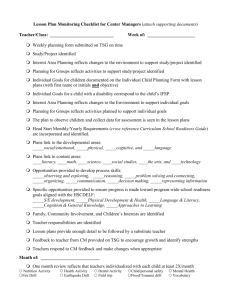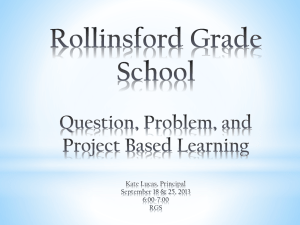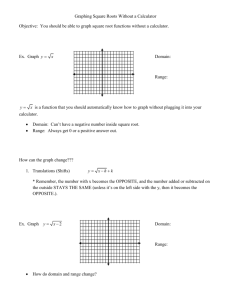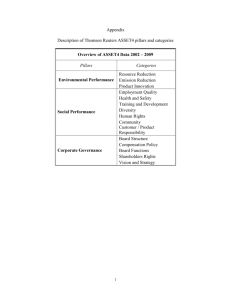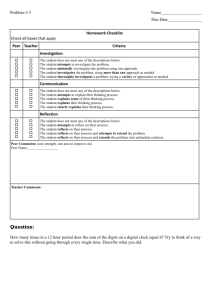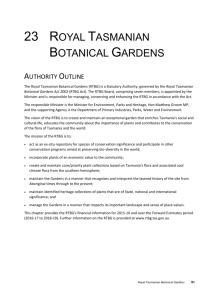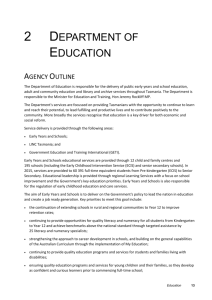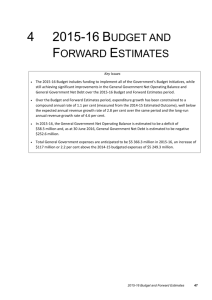Chapter 26 - TasTAFE - Department of Treasury and Finance
advertisement
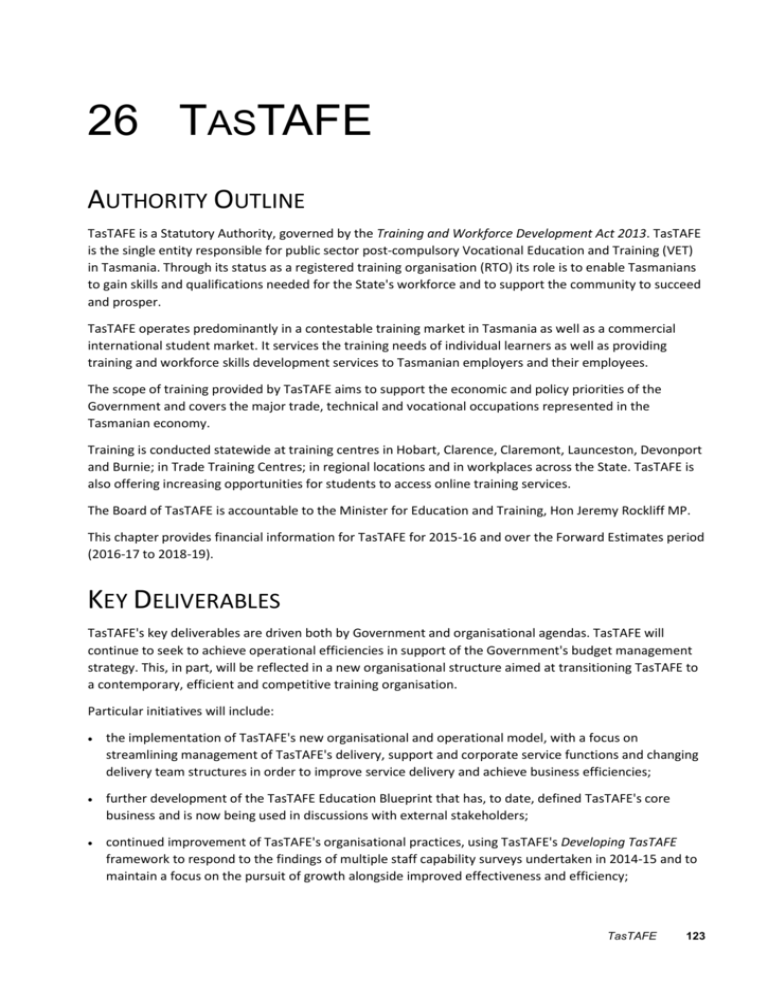
26 TASTAFE AUTHORITY OUTLINE TasTAFE is a Statutory Authority, governed by the Training and Workforce Development Act 2013. TasTAFE is the single entity responsible for public sector post-compulsory Vocational Education and Training (VET) in Tasmania. Through its status as a registered training organisation (RTO) its role is to enable Tasmanians to gain skills and qualifications needed for the State's workforce and to support the community to succeed and prosper. TasTAFE operates predominantly in a contestable training market in Tasmania as well as a commercial international student market. It services the training needs of individual learners as well as providing training and workforce skills development services to Tasmanian employers and their employees. The scope of training provided by TasTAFE aims to support the economic and policy priorities of the Government and covers the major trade, technical and vocational occupations represented in the Tasmanian economy. Training is conducted statewide at training centres in Hobart, Clarence, Claremont, Launceston, Devonport and Burnie; in Trade Training Centres; in regional locations and in workplaces across the State. TasTAFE is also offering increasing opportunities for students to access online training services. The Board of TasTAFE is accountable to the Minister for Education and Training, Hon Jeremy Rockliff MP. This chapter provides financial information for TasTAFE for 2015-16 and over the Forward Estimates period (2016-17 to 2018-19). KEY DELIVERABLES TasTAFE's key deliverables are driven both by Government and organisational agendas. TasTAFE will continue to seek to achieve operational efficiencies in support of the Government's budget management strategy. This, in part, will be reflected in a new organisational structure aimed at transitioning TasTAFE to a contemporary, efficient and competitive training organisation. Particular initiatives will include: the implementation of TasTAFE's new organisational and operational model, with a focus on streamlining management of TasTAFE's delivery, support and corporate service functions and changing delivery team structures in order to improve service delivery and achieve business efficiencies; further development of the TasTAFE Education Blueprint that has, to date, defined TasTAFE's core business and is now being used in discussions with external stakeholders; continued improvement of TasTAFE's organisational practices, using TasTAFE's Developing TasTAFE framework to respond to the findings of multiple staff capability surveys undertaken in 2014-15 and to maintain a focus on the pursuit of growth alongside improved effectiveness and efficiency; TasTAFE 123 continued efforts to keep TasTAFE's training activities and capabilities focussed on industry need as well as social and economic drivers, with particular attention on the decline in employer demand for apprentices and the continuing need to support young Tasmanians who are not in work; the pilot of a vocational education initiative that will work with 3 000 students drawn from TasTAFE and private RTOs with a view to measuring the progress of their core skills around literacy, numeracy, reasoning and writing twice over a 12 month period. The initiative will apply customised inputs based on the initial assessments to seek to achieve measurable increases in these skills that make individuals better at their jobs; new business growth initiatives generated through the Growing TasTAFE framework, with a focus on improving engagement with prospective and existing students through formal frameworks and improved use of technology, as well as a comprehensive campaign to increase student numbers through open days and pop-up information booths; continued growth in the use of TasTAFE's virtual learning environment to modernise educational practices by providing TasTAFE students with access to more online learning opportunities and learning resources; and the implementation of a newly acquired student management system in two stages in 2016 and 2017 at an estimated total cost of $5.8 million. 124 TasTAFE DETAILED BUDGET STATEMENTS Table 26.1: Statement of Comprehensive Income 2014-15) Revenue and other income from transactions Grants1 Sales of goods and services2 Total revenue and other income from transactions Expenses from transactions Employee benefits3 Depreciation and amortisation4 Supplies and consumables Borrowing costs 2015-16) 2016-17) 2017-18) 2018-19) Forward) Forward) Forward) Budget) Budget) Estimate) Estimate) Estimate) $'000) $'000) $'000) $'000) $'000) 80 473) 78 579) 76 850) 77 856) 78 875) 27 505) 25 850) 26 657) 27 476) 28 321) 107 978) 104 429) 103 507) 105 332) 107 196) 75 218) 71 144) 71 977) 73 673) 74 703) 9 000) 9 000) 9 570) 9 570) 9 570) 30 435) 29 524) 29 842) 30 465) 30 541) 29) 1) ....) ....) ....) 114 682) 109 669) 111 389) 113 708) 114 814) (6 704) (5 240) (7 882) (8 376) (7 618) (6 704) (5 240) (7 882) (8 376) (7 618) 15 000) ....) 17 500) ....) ....) changes in equity 15 000) ....) 17 500) ....) ....) Comprehensive result 8 296) (5 240) 9 618) (8 376) (7 618) Total expenses from transactions Net result from transactions (net operating balance) Net result Other economic flows - other non-owner changes in equity Changes in physical asset revaluation reserve5 Total other economic flows - other non-owner Notes: 1. The decrease in Grants in 2015-16 reflects the reclassification of revenue generated through services provided to the Department of Education to Sales of goods and services, partly offset by additional funding associated with the 27 th pay. The decrease in 2016-17 reflects the removal of funding for the 27th pay. 2. The decrease in Sales of goods and services in 2015-16 reflects declining contestable training revenue through increased competition with private RTOs, partly offset by the reclassification of revenue generated through services provided to the Department of Education from Grants. 3. The decrease in Employee benefits in 2015-16 reflects the organisational redesign undertaken by TasTAFE in 2014-15. 4. The increase in Depreciation and amortisation in 2016-17 reflects the amortisation of the new Student Management System. 5. The movements in Changes in physical asset revaluation reserve reflect the anticipated increase in valuation of land and buildings. TasTAFE 125 Table 26.2: Statement of Financial Position as at 30 June 2015) 2016) 2017) 2018) 2019) Forward) Forward) Forward) Budget) Budget) Estimate) Estimate) Estimate) $'000) $'000) $'000) $'000) $'000) 3 550) 666) 1 059) 1 031) 1 811) 3 317) 5 506) 5 231) 5 431) 5 281) 6 867) 6 172) 6 290) 6 462) 7 092) 381) 291) 291) 291) 291) 251 156) 237 887) 247 587) 239 089) 230 591) ....) 3 324) 3 324) 3 324) 3 324) 251 537) 241 502) 251 202) 242 704) 234 206) 258 404) 247 674) 257 492) 249 166) 241 298) 1 506) 1 693) 1 593) 1 843) 1 793) 917) ....) ....) ....) ....) 16 395) 17 599) 17 899) 17 699) 17 499) ....) 20) 20) 20) 20) 18 818) 19 312) 19 512) 19 562) 19 312) 239 586) 228 362) 237 980) 229 604) 221 986) 229 608) 228 346) 228 346) 228 346) 228 346) Reserves 19 628) 16 976) 34 476) 34 476) 34 476) Accumulated funds (9 650) (16 960) (24 842) (33 218) (40 836) 239 586) 228 362) 237 980) 229 604) 221 986) Assets Financial assets Cash and deposits1 Receivables2 Non-financial assets Inventories2 Property, plant and equipment2 Other assets Total assets Liabilities Payables Interest bearing liabilities3 Employee benefits2 Other liabilities Total liabilities Net assets (liabilities) Equity Contributed Capital Total equity Notes: 1. The decrease in Cash and deposits in 2016 reflects the purchase of the new Student Management System. 2. The decrease in Inventories and Property, plant and equipment and the increase in Receivables and Employee benefits in 2016 reflects revised estimates based on 30 June 2014 actuals. 3. Interest bearing liabilities reflects the inherited liabilities from the former Tasmanian Skills Institute and Tasmanian Polytechnic, which are scheduled to be repaid by June 2016. 126 TasTAFE Table 26.3: Statement of Cash Flows 2014-15) 2015-16) 2016-17) 2017-18) 2018-19) Forward) Forward) Forward) Budget) Budget) Estimate) Estimate) Estimate) $'000) $'000) $'000) $'000) $'000) 80 473) 78 579) 76 850) 77 856) 78 875) 27 630) 25 550) 26 932) 27 276) 28 471) Cash flows from operating activities Cash inflows Grants1 Sales of goods and services2 GST receipts 5 754) 5 572) 5 595) 5 618) 5 640) 113 857) 109 701) 109 377) 110 750) 112 986) (67 533) (65 393) (63 579) (65 441) (66 330) Superannuation (7 998) (8 037) (8 098) (8 432) (8 573) Borrowing costs (29) (1) ....) ....) ....) (5 754) (5 572) (5 595) (5 618) (5 640) (30 135) (29 474) (29 942) (30 215) (30 591) (111 449) (108 477) (107 214) (109 706) (111 134) 2 408) 1 224) 2 163) 1 044) 1 852) (2 500) (3 130) (1 770) (1 072) (1 072) Net cash from (used by) investing activities (2 500) (3 130) (1 770) (1 072) (1 072) Cash flows from financing activities Net borrowings5 (1 658) (843) ....) ....) ....) Net cash from (used by) financing activities (1 658) (843) ....) ....) ....) (1 750) (2 749) 393) (28) 780) 5 300) 3 415) 666) 1 059) 1 031) 3 550) 666) 1 059) 1 031) 1 811) Total cash inflows Cash outflows Employee benefits3 GST payments Supplies and consumables Total cash outflows Net cash from (used by) operating activities Cash flows from investing activities Payments for acquisition of non-financial assets4 Net increase (decrease) in cash and cash equivalents held Cash and deposits at the beginning of the reporting period Cash and deposits at the end of the reporting period Notes: 1. The decrease in Grants in 2015-16 reflects the reclassification of revenue generated through services provided to the Department of Education to Sales of goods and services, partly offset by additional funding associated with the 27 th pay. The decrease in 2016-17 reflects the removal of funding for the 27th pay. 2. The decrease in Sales of goods and services in 2015-16 reflects declining contestable training revenue through increased competition with private RTOs, partly offset by the reclassification of revenue generated through services provided to the Department of Education from Grants. 3. The decrease in Employee benefits in 2015-16 reflects the organisational redesign undertaken by TasTAFE in 2014-15. TasTAFE 127 4. The increase in Payments for acquisition of non-financial assets in 2015-16 reflects payments for the purchase of the new Student Management System and other equipment replacements. 5. The decrease in Net borrowings in 2015-16 reflects the repayment of a loan provided from Finance-General to the former Tasmanian Skills Institute under the Targeted Voluntary Redundancy Program. 128 TasTAFE
